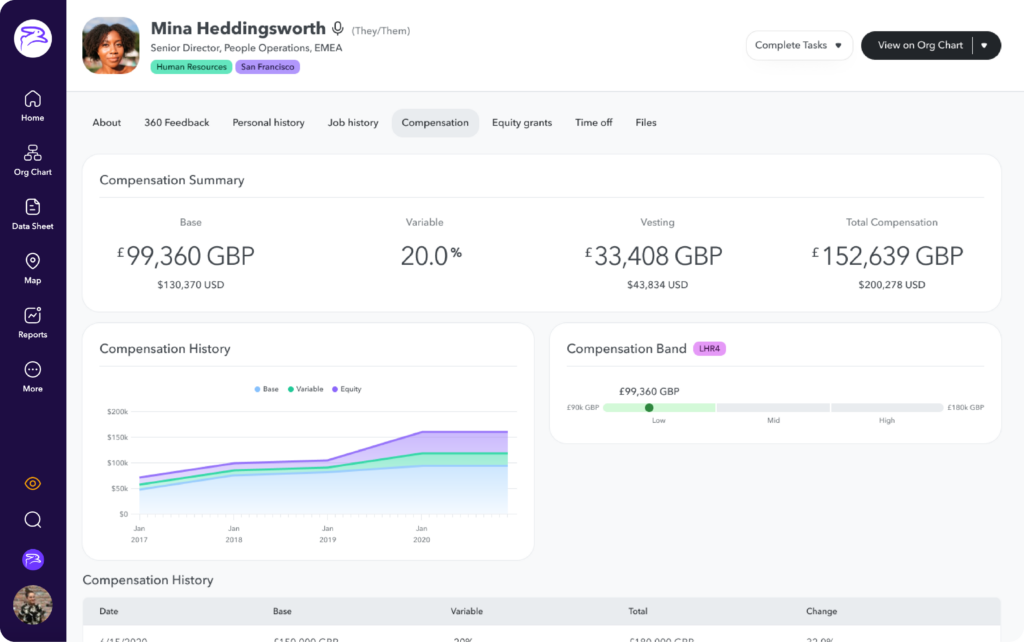
If you want a winning team, you need to treat them like champions. That’s why many leaders are prioritizing building a people-first culture, or creating an environment in which employees are valued and prioritized (e.g. establishing a psychologically-safe workplace, creating personalized professional development opportunities, and promoting work-life balance).
In other words, a strong People experience doesn’t mean Friday pizza parties or pingpong tables in the break room. Instead, it’s one that acknowledges and prioritizes employees’ personal and professional experiences.
And the benefits of putting people first positively impacts your whole organization. Treating your people like MVPs leads to better morale, increased motivation, and a happier, more productive workforce. Leaning into your people-first culture also makes your company a more attractive place to work, which means you’ll have a better chance at getting top talent to join your team.
Ready to prioritize creating or improving your people-first culture? The first step is to shift your mindset. Jarret Austin, Owner of Bankruptcy Canada Inc, explains: “A people-first mindset is a philosophical concept. It can’t be constructed out of some blocks or with the help of some tools.”
In other words, creating the best people strategy isn’t just a one-and-done task, but a living, breathing thing that you need to constantly revisit and iterate on to better support your people.
So while the next eight tips might seem like a check-list, they’re not. Instead, they’re ongoing improvements to consistently work towards to help you create an environment that feels respectful, inclusive, and dedicated to making people-first decisions.
Your company values aren’t just words or phrases that live on a piece of paper. Instead, they provide direction, purpose, and a sense of identity for both employees and customers – and should permeate every aspect of your organization.
Over at Aper, Head of People Guiliana Zara wanted to ensure their culture grew with the company as they scaled their headcount plans. In order to do so, they embedded their values throughout the organization. She explains: We include “the Aper values in every process that we launch or modify, that way it serves as the roots for everything we do (including feedback surveys, salary reviews, and onboarding). We also feature our values front and center during company-wide events like Town Halls and when we recognize our people’s achievements.”
And Zara’s team’s impact was powerful. After implementing various surveys to gather feedback about employee experience initiatives, they’re happy to report that their eNPS score grew 70% from 2020 to 2021.
Move over, cultural-fit. If you’re working to build a strong people strategy, it’s time to pivot from hiring someone that “fits perfectly” on your team to hiring someone that brings a fresh perspective and helps your team grow. What we’re talking about here is hiring for cultural add.
To ensure you’re hiring for cultural add, look to diversify your candidate pipeline. That’s exactly what Guusto did as part of their effort to increase representation on their executive team (in terms of gender, ethnicity, mental wellness, LGBTQ+).
Noah Warder, Head of People, explains the strategy behind sourcing candidates: “We’re not just looking at traditional backgrounds and we’re very intentional when working with Talent Acquisition that we want to speak to more women, we want to speak to more people of color, we want to speak to more people who are not just the dominant white male in society. We make it very clear early in the process that representation does matter in this organization and we want to have those distinct viewpoints in our leadership.”
But finding the right candidates for cultural add is just half of Guusto’s hiring strategy. The other is the actual interview process, in which they have a variety of people (from different levels and perspectives) on the interview panel.
A people-first culture requires investing in the growth and development of your employees, no matter your company’s size. In short, employee development ensures that your people have the necessary skills and knowledge to be successful in their roles, now and in the future.
Joanna Wise, Senior VP of People at Whip Media, is no stranger to the world of employee development: she creates, delivers, and evaluates People programs, especially when it comes to learning and development (L&D). Specifically, she builds mentoring and manager development programs for her organization to boost innovation and help employees achieve professional and personal growth. She explains about their People strategy, “Our goal was to promote a culture that sees mentorship as an effective way of developing individuals, sharing new ideas, and creating a shared vision.”
Investing in employee development isn’t just for “the good of the company.” It’s also what people want. Studies show that:
By providing your employees with the necessary tools and resources to grow, you show that you value them and their contributions to your company. Overall, investing in employee development can play a significant role in creating a people-first culture.
As a people-first leader, it’s critical to consider the voice of the employee. Daniel Apke, CEO of Land Investing Online, explains: “Employee voice is an essential element for the survival, stability, and high performance of any business and organization. To know what your people think, want, and need, you don’t have to be a mind-reader. You just need to ask them, listen, and react.”
And something that a lot of employees are asking for is transparency (in fact, only 33% of employees trust their leadership…yikes). Ultimately, transparency helps promote accountability and responsibility, encourage communication and collaboration, prevent misunderstandings, and instills trust in employees – all things people-first companies are striving to achieve.
While it’s clear that transparency can solve a lot of problems in the workplace, it’s a little bit hazy on how to establish transparency within your culture.
Ian White, founder and CEO of ChartHop, believes one of the first steps to increasing transparency is democratizing your people data. He writes: “When data like employee feedback, 1:1 notes, org charts, etc is shared across an organization, it creates visibility and flips employee data on its head by taking an employee-first approach. With people data built for people, employees understand:
An increase in transparency clarifies individual growth, inspiring and empowering employees to accomplish their goals without micromanagement.”

Equipping your people with the right employee experience platform allows them to keep track of their performance reviews, career progress, and compensation – without going through the People team.
A healthy work-life balance is easier said than done, especially if you’re in a new role, working at a fast-paced start-up, or still getting the hang of working from home (yes I see you, overflowing laundry basket).
But creating a people-first culture requires leaders to model a healthy work-life balance. This means carving out time for themselves, as well as their team, to ensure they are taking care of their physical, mental, and emotional health.
Over at Mixbook, People Director Kim Colucci believes modeling work-life balance is a key step in building trust with employees. And when she says that she encourages employees to voice concerns, she practices what she preaches. Colucci says, “We make time and prioritize being together, building trust, and being vulnerable, not only to develop positive relationships, but also to help make future problem solving and work disagreements less personal.”
To provide (and model) a healthy work-life balance:
When it comes to putting people first, celebrating successes and learning from failures is a key part of creating a people-first culture. Why? It has to do with the intention behind it: you want to recognize your people’s efforts and focus on development opportunities for the future.
When it comes to celebrating wins, it’s important to acknowledge teammates’ efforts and showcase accomplishments. Celebrating successes can come in many forms, such as awarding bonuses or public recognition at All Hands meetings. Doing so reinforces the idea that hard work pays off and encourages employees to strive for excellence.
![Employee Spotlight Template [ChartHop] (1)-01](https://www.charthop.com/wp-content/uploads/2022/11/Employee-Spotlight-Template-ChartHop-1-01-1024x576.png)
Consider using spotlight templates for employee recognition to not only highlight your people’s efforts, but to also create an efficient process for your people team.
While giving high-fives all around comes easily, it’s much harder to sit down and work through what went wrong. But here’s that intentionality again: Instead of placing blame on individuals when things go wrong, organizations with a people-first culture look for ways to improve the process and prevent similar mistakes from happening again. Ultimately, this mindset helps foster a workplace culture of continual improvement, growth, and healthy vulnerability.
For instance, the marketing team at Crediful promotes a culture of growth by creating digital versions of bulletin boards for people to add to, engage with, and discuss. CMO Colin Palfrey explains the concept of the two “walls”:
“The Success Wall enumerates all the achievements and milestones (even the smallest ones) by our team of finance writers, journalists, and editors. For example, looking at what financial tools have been tested already or how many how-to guides on personal finance the team has published so far.
The Failure Wall is a reminder of some typical mistakes they make while preparing the content. Having these walls, we celebrate failures as much as successes. There are Heroic Mistake awards for those who take risks, experiment, try something new, but suffer defeats. In this case, they do not feel ashamed or humiliated for failing, because they are rather perceived by teammates as daredevils and motivators.”
Benefits packages are an important aspect of your employee experience strategy and can play a significant role in attracting and retaining top talent. That’s because, when you create a well-rounded benefits package, you help address the financial, physical, and emotional well-being of your employees. In turn, you’re signaling to your people that you are committed to their well-being and value their contributions to your company.
If you’re ready to reimagine your benefits offerings, look to My Doan Cong, Head of People at ALT, who used survey results to build an extensive Wellness program that took what employees wanted, what they needed, and allotted budget into consideration. She encourages other leaders to focus on the wellness of their employees by tracking “self-reported energy levels of employees, stress levels, engagement, confidence in the business, sense of belonging, and events and program ROI to spend.”
The best employee experience strategies are evident throughout the employee lifecycle. That’s why Devin Blase, VP of People at Truework, aligned with her organization’s founders on how to build a people-first strategy in every part of the employee journey.
Blase describes her team’s multi-step approach when it comes to employee development and pay transparency: “I try to take a practical approach to this [people-first] mindset, boiling it down to what people want out of their careers and then giving them a transparent roadmap and timeline for how to get there. At Truework, that meant:
And over at MURAL, Chief People Officer Adriana Roche created an engaging and supportive onboarding experience to advertise their people-first culture to candidates and new hires. One of her goals was to personalize the onboarding process for all types of learners. She clarifies: “Information is accessible through murals (visual), The Record (traditional reading material), and interactive in-person sessions with the leadership team. All of these different venues of information help to create an onboarding experience that is truly supportive to our diverse team, especially entry-level teammates.”
If you’re ready to adopt a people-first approach – or improve the one you’ve already implemented – start by implementing the eight strategies above.
As you know, creating a people-first culture is an ever-evolving process – one that involves constant analysis and transparency to ensure your efforts are working. Further, it isn’t the job of one person, or even a team; it’s a collective effort of all People leaders and managers to help ensure a healthy and positive employee experience.
Sign up for a free demo today.